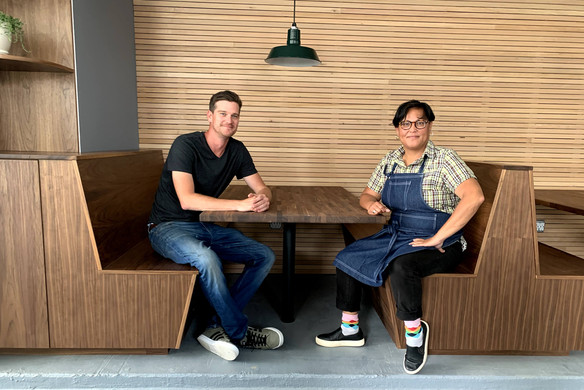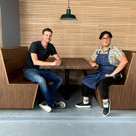Table of contents
“Among all the challenges, we’ve seen businesses show great resiliency over the past year, sometimes making dramatic changes to the way they operate.” says Felipe Chacon, an economist with Square who tracks consumer spending, small businesses, the evolution of payments, and the broader economy. “Business owners have had to go from in-person to online, adopt new delivery and curbside pickup options, and in some cases switch from largely al la carte to subscription-based models of revenue in the process of adapting to this new way of doing business during the pandemic.”
Small businesses are adapting quickly
Small businesses saw an increase in card-not-present payments, including online sales. According to Chacon, card-not-present payments (among active sellers who accept both cash and card transactions with their Square Hardware) increased by more than five times from February to April when shelter-in-place mandates were first put in place.
The businesses that saw the largest shift to online and over-the-phone commerce were food and drink industry businesses. These businesses were also most impacted by pandemic-related restrictions and concerns. With changing guidelines around safety protocols like mask-wearing and social distancing, restaurants looked to eCommerce, curbside delivery, and pickup (amongst other options) to make purchasing food as contactless as possible.
How have business owners responded to this new way of doing business?
FC: If we compare businesses that started using Square to process payments in 2019 with 2020 during the pandemic, the types of businesses new to using the platform held remarkably steady with a few exceptions that were a surprise to us. During the five months ending October 2019 and with the same five-month period ending October 2020, the share of businesses identifying as food or drink, beauty and personal care, and healthcare and fitness that were newly using Square to process payments actually increased compared to other verticals.
These are the sectors that have been most directly impacted by evolving attitudes and policy responses to the pandemic. While it’s hard to say from the data who is joining Square as a new business versus an existing business that is switching to Square, we think this is the result of a combination of existing businesses needing to adapt and grow out their payment options to include more card-not-present and non-cash options, combined with new entrants seeing opportunity in the rapidly changing business landscape.
We’ve learned a lot about how the pandemic has affected so many industries, one in particular being restaurants. How have restaurants demonstrated resilience during these times?
FC: Food sellers have generally fared well during the pandemic. Spending more time at home, people have taken up grocery shopping and cooking for themselves at higher rates.
Restaurants, however, have been more directly affected by COVID restrictions and shelter-in-place mandates, and many have had to get scrappy. Early on in the pandemic and in places with more stringent shelter-in-place mandates, in addition to pivoting to online and takeout models, many restaurants began selling items that would typically be picked up at grocery stores and other retail stores — such as eggs by the dozen or flat, toilet paper, coffee by the pound, and DIY meal kits.
In addition to buying household essentials, home goods and other homebody products have gained popularity with consumers. How are these buying habits going to impact small businesses in 2021 and beyond (even after we have a vaccine)?
FC: While the days of restaurants selling toilet paper and eggs by the dozen may be behind us for the most part, there are also changes that many businesses made that will stick around as long as they continue to be a source of revenue.
Coffee shops that started selling coffee by the pound will likely continue to do so, as it is not much of a departure from what they would normally be selling. Whether or not these more subtle shifts in goods and services remain after a vaccine is widely available will depend more on the degree to which consumer habits that formed during the pandemic persist going forward.
At this time, vaccine administration for healthcare personnel and other frontline essential workers is already underway across the United States. As these vaccinations expand to newly eligible groups, businesses may start looking to a hybrid way of operating, leveraging the new tools and systems they’ve developed while navigating an ever-changing way of doing business, keeping both their employees and customers safe.
How are restaurants and grocers optimizing their business operations to keep up with changing consumer behaviors?
FC: In the food and beverage industry, grocery stores have generally fared well during the pandemic. Consumers are spending more time at home and, thus, have taken to grocery shopping and cooking at higher rates.
While new sales offerings served as useful sources of revenue in the early days of the pandemic, the much bigger factor in a restaurant’s capacity to adjust to a post-pandemic world comes down to its ability to serve takeout and provide delivery options. Food and beverage sellers have seen the largest and most sustained swing away from in-person transactions compared to other industries.
Speaking of in-person interactions, we know shelter-in-place orders provided a rise in eCommerce, but what’s next for businesses who made that leap?
FC: The shift to eCommerce and remote transacting in general, largely driven by the pandemic, has touched almost every aspect of the way businesses and consumers transact. Along with the huge rise in the share of digital, online, and/or phone transactions, this holiday season saw a big jump in the use of gift cards.
Gift card sales were up 30 percent year over year during the 30 days leading up to Christmas 2020, and the share of those gift cards that were eGift cards more than doubled to make up 20 percent of all gift card sales. Businesses that have adapted to the demands of the changing landscape of commerce during the pandemic by adding an online presence and payment options that don’t need to be completed in-person will continue to benefit from those new selling channels, even after a vaccine is more widely available.
Small businesses are seeking financing
The first round of PPP, a $669 billion program, saw a huge response from small businesses in need of relief after struggling to remain open amid the COVID-19 pandemic. Square Capital facilitated more than $850 million in PPP loans during the first round with beauty and personal care, professional services and healthcare, and fitness services seeing the largest loans by volume and size.
As businesses look to what a second round of PPP might mean, 30 percent of business owners still say that the pandemic has had a large negative effect on their businesses, a statistic followed closely by an additional 44 percent that say it has had a moderately negative effect on their businesses.
One thing a lot of small business owners have their eye on is PPP. Did PPP help small businesses in any way? In what ways could a second round of PPP be helpful?
FC: While it’s still a little early to know how recipients of PPP loans have fared, the re-emergence of discussions about providing additional PPP funding on a bipartisan level shows both the need and desire to better provide targeted relief funding to small businesses. With access to capital consistently being among the top concerns of business owners in normal times, there is little doubt that these infusions of cash during the pandemic have been a welcomed resource.
But the first round of PPP was not a slam dunk for businesses, and ongoing discussions surrounding additional PPP funding show a committed effort to address some of the funding and forgiveness issues for small businesses at the federal level.
Are there any other economic trends for small business owners that you’ve observed since the onset of the pandemic? If yes, could you share some of what those leading indicators were?
FC: Not only have we seen a rise in card-not-present transactions, but even among transactions that are made in person. We have seen consumers pulling away from cash use — and at a much faster rate than before. To be clear, cash use has been waning for a couple of decades now as credit and debit card use has become more ubiquitous, and mobile payment options have emerged more recently as another option. But the recent fall in cash usage, which largely occurred during the six-month period from March through September of 2020, would have taken several years under normal conditions.
Resiliency is the capacity to recover from difficulties quickly, something small business owners have experienced first hand since the start of 2020. In June of 2020, the U.S. Census Bureau launched a tracker to estimate community resilience as small businesses absorbed, endured, and began to recover from the impacts of the pandemic as households. Small business owners have had a challenging year navigating changes in consumer behavior, changing safety protocols and, for many, learning the ins and outs of cash flow management amid a global pandemic.
Despite these challenges, applications for new businesses saw its highest increase in 13 years. This year the economic impact of the pandemic has forced some businesses to close — some temporarily, others permanently — but it has also shown us the resilience of small businesses that have adapted and evolved as they braved uncharted waters.
![]()








